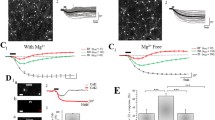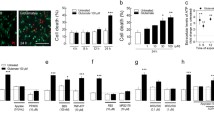Summary
In an attempt to find an marker for nerve cell death in vivo, the ATP content was measured in the rat dorsal hippocampus within hours or days following in the local injection of the excitotoxins quinolinic or kainic acid. Beginning or completed neuronal degeneration is accompanied by significant decreases in ATP levels. Selective blockade of the quinolinic acid-induced decrement in ATP content by D-(−) 2-amino-7-phosphonoheptanoic acid indicates that ATP measurements may of value for the rapid in vivo screening of the anti-neurotoxic properties of pharmacologically distinct excitatory amino acid receptor antagonists.
Similar content being viewed by others
References
Biziere K, Coyle JT (1978) Influence of corticostriatal afferents on striatal kainic acid neurotoxicity. Neurosci Lett 8: 303–310
Campochiaro P, Coyle JT (1978) Ontogenetic development of kainate neurotoxicity: correlates with glutamatergic innervation. Proc Natl Acad Sci USA 75: 2025–2029
Coyle JT, Bird SJ, Evans RH, Gulley RL, Nadler JV, Nicklas WJ, Olney JW (1981) Excitatory amino acid neurotoxins: selectivity, specificity and mechanisms of action. Neurosci Res Progr Bull 19: 331–427
Coyle JT, Schwarcz R, Bennett JP, Campochiaro P (1977) Clinical, neuropathologic and pharmacologic aspects of Huntington's disease: correlates with a new animal model. Progr Neuropsychopharmacol 1: 13–30
Evans RH, Francis AA, Jones AW, Smith DAS, Watkins, JC (1982) The effect of a series ofΩ-phosphonic-α-carboxylic amino acids on electrically evoked and excitant amino acid-induced responses in isolated spinal cord preparation. Br J Pharmacol 75: 65–75
Foster AC, Collins JF, Schwarcz R (1983) On the excitotoxic properties of quinolinic acid, 2,3-piperidine dicarboxylic acids and structurally related compounds. Neuropharmacology 22: 1331–1342
Fuxe K, Roberts P, Schwarcz R (eds) (1983) Excitotoxins. Macmillan Press, London
Hoffman NE, Liao JC (1977) Reversed phase high-performance liquid chromatographic separations of nucleotides in the presence of solvophobic ions. Anal Chem 49: 2231–2234
Köhler C, Schwarcz R, Fuxe K (1979) Hippocampal lesions indicate differences between the excitotoxic properties of acidic amino acids. Brain Res 175: 366–371
McGeer EG, McGeer PL, Singh K (1978) Kainate-induced degeneration of neostriatal neurons: dependence upon corticostriatal tract. Brain Res 139: 381–383
McLennan H (1983) Receptors for excitatory amino acids in the mammalian central nervous system. Prog Neurobiol 20: 251–271
Monaghan DT, Yao D, Cotman CW (1985) L-[3H]-glutamate binds to kainate-, NMDA-, and AMPA-sensitive binding sites: an autoradiographic analysis. Brain Res 340: 378–383
Nicklas WJ, Krespan B, Berl S (1980) Effects of kainate on ATP levels and glutamate metabolism in cerebellar slices. Eur J Pharmacol 62: 209–213
Olney JW (1974) Toxic effects of glutamate and related amino acids on the developing central nervous system. In: Nyhan WL (ed) Heritable disorders of amino acid metabolism. John Wiley, New York, pp 501–512
Retz KC, Coyle JT (1982) Effects of kainic acid on high-energy metabolites in the mouse striatum. J Neurochem 38: 196–203
Retz KC, Coyle JT (1980) Kainic acid lesion of mouse striatum: effects on energy metabolites. Life Sci 27: 2495–2500
Rothman SM (1986) Glutamate and anoxic neuronal death in vitro. In: Schwarz R, Ben-Ari Y (eds) Excitatory amino acids and epilepsy. Plenum, New York, pp 687–695
Schwarcz R, Brush GS, Foster AC, French ED (1984) Seizure activity and lesions after intrahippocampal quinolinic acid injection. Exp Neurol 84: 1–17
Schwarcz R, Collins JF, Parks DA (1982)α-amino-Ω-phosphonocarboxylates block ibotenate but not kainate neurotoxicity in rat hippocampus. Neurosci Lett 33: 85–90
Schwarcz R, Foster AC, French ED, Whetsell WO Jr, Köhler C (1984) Excitotoxic models for neurodegenerative disorders. Life Sci 35: 19–32
Schwarcz R, Meldrum B (1985) Excitatory amino acid antagonists provide a therapeutic approach to neurological disorders. Lancet 2: 140–143
Stone TW, Perkins MN (1981) Quinolinic acid: a potent endogenous excitant at amino acid receptors in rat CNS. Eur J Pharmacol 72: 411–412
Watkins JC, Evans RH (1981) Excitatory amino acid transmitters. Annu Rev Pharmacol Toxicol 21: 165–204
Author information
Authors and Affiliations
Additional information
Dr. Wu is on leave from Department of Pharmacology, Nanjing College of Pharmacy, Nanjing, The People's Republic of China.
Rights and permissions
About this article
Cite this article
Vezzani, A., Sangalli, L., Wu, H.Q. et al. ATP as a marker of excitotoxin-induced nerve cell death in vivo. J. Neural Transmission 70, 349–356 (1987). https://doi.org/10.1007/BF01253609
Received:
Accepted:
Issue Date:
DOI: https://doi.org/10.1007/BF01253609




